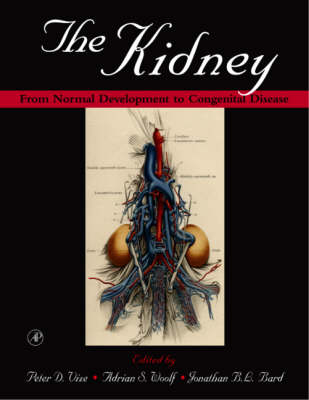
The Kidney
Academic Press Inc (Verlag)
978-0-12-722441-1 (ISBN)
Organogenesis of the kidney has been intensely studied for over a century. In recent years advances in molecular techniques have not only made great inroads into exploring the genetic regulation of this complex process but also began to unravel the molecular basis of many forms of congenital kidney disease. This book is a comprehensive study on these findings and the only book available with such in depth coverage of the kidney.
Peter D. Vize uses the many advantages of model systems to explore the very first events in kidney development. These studies have characterized both the inductive signals that initiate kidney formation and also characterized the genetic response to these signals. Adrian Woolf heads the Nephro-Urology Unit at the Institute of Child Health. His research focuses on defining the biological basis of low numbers of glomeruli; on elucidating the normal mechanisms of renal vessel differentiation; vascular remodeling in kidney disease; and the study of the clinical and genetic aspects of primary vesicoureteric reflux, duplex kidneys, glomerulocystic diseases (oral-facial-digital type 1 and the Renal Cysts and Diabetes syndromes), Bardet-Biedl syndrome, Kallmann's syndrome etc. Jonathan Bard is a developmental biologist whose main interests are kidney development, the generation of structures in embryos and bioinformatics. He currently works on the cellular basis of nephron formation and on making ontologies of vertebrate anatomy for gene-expression databases (see http://genex.hgu.mrc.ac.uk" target="_blank">http://genex.hgu.mrc.ac.uk)
SECTION 1: EMBRYONIC KIDNEYS AND MODELS 1. Introduction: the embryonic kidneys and other nephrogenic models 2. Development of the Malpighian tubules in Drosophila melanogaster 3. Induction, development and physiology of the pronephric tubules 4. Formation of the nephric duct 5. The pronephric glomus and vasculature 6. Development of the mesonephric kidney 7. 3-Dimensional anatomy of mammalian mesonephroi 8. The Molecular control of pronephros development- an Overview 9. Embryological, genetic and molecular tools for investigating embryonic kidney development
SECTION 2: THE ADULT KIDNEYS 10. Introduction 11. Anatomy and Histology of the Human Urinary System 12. Development of the Ureteric Bud 13. The Fates of the Metanephric Mesenchyme 14. The Formation and Development of Nephrons 15. Establishment of polarity in epithelial cells of the developing nephron 16. Development of the Glomerular Capillary and its Basement Membrane 17. The development of kidney blood vessels 18. The Development of function in the metanephric kidney 19. Experimental methods for studying urogenital development 20. Overview: The Molecular Basis of Kidney Development
SECTION 3: CONGENITAL DISEASE 21. Maldevelopment of the Human Kidney and Lower Urinary Tract: an Overview 22. Wilms' Tumor and related disorders 23. Pax-2 and Renal-Coloboma Syndrome 24. Polycystic Kidney Disease, von Hippel Lindau and Tuberous sclerosis 26. Renal Cell Carcinoma: The Human Disease 27. The Tubule 28. Diseases of the Glomerular Filtration Barrier: Alport Syndrome and Congenital Nephrosis (NPHS1) 29. Congenital Kidney Diseases: Prospects for New Therapies
| Erscheint lt. Verlag | 14.3.2003 |
|---|---|
| Verlagsort | San Diego |
| Sprache | englisch |
| Maße | 216 x 279 mm |
| Gewicht | 1550 g |
| Themenwelt | Medizinische Fachgebiete ► Innere Medizin ► Nephrologie |
| ISBN-10 | 0-12-722441-6 / 0127224416 |
| ISBN-13 | 978-0-12-722441-1 / 9780127224411 |
| Zustand | Neuware |
| Haben Sie eine Frage zum Produkt? |
aus dem Bereich


